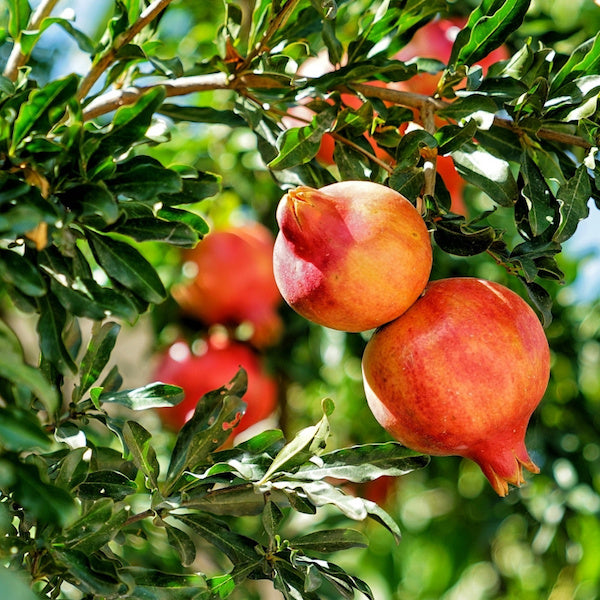My Store
Pomegranate
Pomegranate
Couldn't load pickup availability
Plant Type: fruit
Plant Height: 6-20 feet
Spread: 4-15 feet
Flower Color: orange-red
Sun Exposure: Full sun
Description:
The Pomegranate tree, scientifically known as Punica granatum, is a captivating and fruitful fruit tree that can thrive in the Arizona landscape, particularly in regions with a hot and arid climate. Pomegranates are known for their unique and delicious fruits, stunning blossoms, and adaptability. They add a touch of exotic flavor, culinary versatility, and ornamental beauty to gardens and outdoor spaces.
Key Features of Pomegranate Trees:
1. Fruit: Pomegranates produce distinctive round fruits with a tough, outer skin that encases juicy and sweet-tart arils (seed sacs). Pomegranate arils are prized for their refreshing and tangy flavor. They can be eaten fresh, used in salads, juices, cocktails, and a variety of dishes.
2. Blossoms: Pomegranate trees bear striking and vibrant red or orange blossoms that are not only visually stunning but also attract pollinators, such as bees and butterflies.
3. Foliage: The trees have attractive glossy green leaves that provide shade and visual appeal to gardens.
Growing Pomegranate Trees in Arizona:
1. Variety Selection: Choose pomegranate tree varieties that are well-suited to the local climate and have good heat tolerance. Some suitable pomegranate varieties for Arizona include 'Wonderful,' 'Desertnyi,' and 'Ambrosia.'
2. Planting Location: Select a sunny location for planting your pomegranate tree, as it requires full sun for optimal fruit production. Ensure the site has well-drained soil to prevent root rot.
3. Soil Preparation: Prepare the soil by adding organic matter to improve its water retention and nutrient content. Pomegranate trees tolerate a wide range of soil types but prefer well-draining soil.
4. Watering: Pomegranate trees in Arizona require regular watering, especially during the hot and dry summer months. Use a drip irrigation system to provide moisture directly to the root zone. Be cautious not to overwater, as pomegranates are drought-tolerant once established.
5. Fertilization: Apply a balanced fertilizer according to recommended guidelines to provide essential nutrients for healthy growth and fruit production.
6. Pruning: Prune your pomegranate tree to remove dead or diseased branches and to shape the canopy for better sunlight penetration and air circulation.
7. Pest and Disease Management: Pomegranate trees are relatively low-maintenance but can be affected by pests like aphids and fruit flies. Monitor for signs of pests and implement pest control measures when necessary.
8. Harvesting: Pomegranates should be harvested when they are fully ripe and have a deep red or orange color. The arils can be easily separated from the fruit and enjoyed fresh or used in various culinary applications.
The Pomegranate tree's unique and delicious fruits, vibrant blossoms, and lush foliage make it a valuable addition to gardens in Arizona. With proper care, including regular watering, fertilization, and pest management, pomegranate trees can thrive and provide an abundance of exotic and flavorful arils for culinary enjoyment, adding a burst of unique flavor and visual appeal to the landscape.
Three Timbers Installation Guide (Feel Free to Follow): Pomegranate
Planting Guide:
- Location: Full sun (at least 8 hours of direct sunlight for optimal growth and fruit production)
- Soil: Well-drained, loamy or sandy soil (slightly acidic to neutral soil preferred)
- Spacing: Space trees 10-15 feet apart to allow for optimal growth and air circulation
- Planting Depth: Plant at the same depth as the root ball, ensuring the top of the root ball is level with the surrounding soil surface
- Support: Pomegranate trees may need light staking during early growth but become self-supporting as they mature
Watering Guide:
Watering After Planting:
- Initial Watering: Water thoroughly immediately after planting to saturate the root ball and surrounding soil
- Frequency: Water every 4-5 days for the first 2-3 weeks to help establish the root system
- Watering Amount: Provide 3-4 inches of water per session for deep watering
When is the Plant Established?
- Timeframe: Pomegranate is considered established after 6-8 months when the roots have spread into the surrounding soil
Watering Once Established:
- Summer: Water every 7-10 days during the hotter months. If temperatures exceed 100°F, increase watering to every 5-7 days. Provide 3-4 inches of water per session.
- Winter: Water every 3-4 weeks during the cooler months, depending on rainfall.
Drip Irrigation Setup:
- Placement of Emitters: Place the drip emitters 18-24 inches away from the base of the tree for deep watering
- Flow Rate: Use emitters with a flow rate of 2-4 gallons per hour
- Number of Emitters: 2-3 emitters per tree for even watering distribution
- Adjusting Frequency: In summer, increase watering frequency to every 5-7 days. In winter, reduce to every 3-4 weeks
Share












